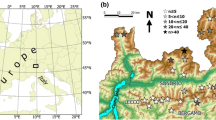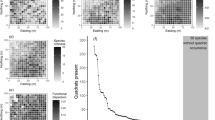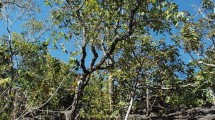Abstract
The role of intraspecific trait variability is increasingly recognized as a key factor shaping plant fitness and community assembly worldwide. Studying the direct effects of habitat heterogeneity on trait expression of individual plants of the same species is a useful tool to quantify intraspecific trait variability locally. We investigated how habitat heterogeneity on granite inselbergs affected intraspecific trait variability of 19 functional traits in three shrub species of the family Proteaceae in south western Australia, a global biodiversity hotspot. We used pairwise comparison (single trait) and multivariate analysis (multiple traits, functional space) to detect shifts in trait patterns. Consistent with our predictions, we found that individuals developing in putatively more stressful habitats (highly sun-irradiated, shallow-soil patches on the outcrops) were characterized by trait expressions indicative of more conservative resource-related strategies when compared with plants occurring in the surrounding woodlands that were experiencing more benign ecological conditions. These results were significant for two out of three species. Granite inselbergs promoted plant longevity, a signal that these granite inselbergs might offer refugial conditions defined as protection against fire.





Similar content being viewed by others
References
Albert CH, Thuiller W, Yoccoz NG, Douzet R, Aubert S, Lavorel S (2010) A multi-trait approach reveals the structure and the relative importance of intra- vs. interspecific variability in plant traits. Funct Ecol 24:1192–1201
Albornoz F, Burgess TI, Lambers H, Etchells H, Laliberté E (2017) Native soilborne pathogens equalize differences in competitive ability between plants of contrasting nutrient-acquisition strategies. J Ecol 105:549–557
Bates BC, Hope P, Smith BRI, Charles S (2008) Key findings from the Indian Ocean climate initiative and their impact on policy development in Australia. Clim Change 89:339–354
Beard JS, Chapman AR, Gioia P (2000) Species richness and endemism in the Western Australian flora. J Biogeogr 27:1257–1268
Bolnick DI., Amarasekare P, Araújo MS, Bürger R, Levine JM, Novak M, Rudolf VHW, Schreiber SJ, Urban MC, Vasseur DA (2011) Why intraspecific trait variation matters in community ecology. Trends Ecol Evol 26:183–192
Burley AL, Phillips S, Ooi MKJ (2007) Can age be predicted from diameter for the obligate seeder Allocasuarina littoralis (Casuarinaceae) by using dendrochronological techniques? Austral J Bot 55:433–438
Burrows ND (2013) Fire dependency of a rock outcrop plant Calothamnus rupestris (Myrtaceae) and implications for managing fire in south-western Australian forests. Austral J Bot 61:81–88
Clarke PJ (2002) Habitat islands in fire-prone vegetation: do landscape features influence community composition? J Biogeogr 29:677–684
Cochrane A, Hoyle GL, Yates CJ, Neeman T, Nicotra AB (2016) Variation in plant functional traits across and within four species of Western Australian Banksia (Proteaceae) along a natural climate gradient. Austral Ecol 41:886–896
Coomes D A, Kunstler G, Canham CD, Wright E (2009) A greater range of shade-tolerance niches in nutrient-rich forests: an explanation for positive richness-productivity relationships? J Ecol 97:705–517
Cornelissen JHC, Lavorel S, Garnier E, Díaz S, Buchmann N, Gurvich DE, Reich PB, ter Steege H, Morgan HD, van der Heijden MGA, Pausas JG, Poorter H (2003) A handbook of protocols for standardised and easy measurement of plant functional traits worldwide. Austral J Bot 51:335–380
Cornwell WK, Ackerly DD (2009) Community assembly and shifts in plant trait distributions across an environmental gradient in coastal California. Ecol Monogr 79:109–26
Cowling RM, Rundel PW, Lamont BB, Arroyo MK, Arianoutsou M (1996) Plant diversity in Mediterranean-climate regions. Trends Ecol Evol 11:362–366
Fitzpatrick MC, Gove AD, Sanders NJ, Dunn R (2008) Climate change, plant migration, and range collapse in a global biodiversity hotspot: The Banksia (Proteaceae) of Western Australia. Global Change Biol 14:1–16
Groom PK (2004) Rooting depth and plant water relations explain species distribution patterns within a sandplain landscape. Funct Pl Biol 31:423–428
Hayes P, Turner BJ, Lambers H, Laliberté E (2014) Foliar nutrient concentrations and resorption efficiency in plants of contrasting nutrient-acquisition strategies along a 2-million-year dune chronosequence. J Ecol 102:396–410
He T, Lamont BB, Downes KS (2011) Banksia born to burn. New Phytol 191:184–196
Hoffman WA, Othen B, Nascimento PKV (2003) Fire ecology of tropical savanna and forest trees. Funct Ecol 17:720–726
Hopper SD, Gioia P (2004) The Southwest Australian Floristic region: evolution and conservation of a global hot spot of biodiversity. Annual Rev Ecol Evol Syst 35:623–650
Jung V, Violle C, Mondy C, Hoffmann L, Muller S (2010) Intraspecific variability and trait-based community assembly. J Ecol 98:1134–1140
Jung V, Albert CH, Violle C, Kunstler G, Loucougaray G, Spiegelberger T (2014) Intraspecific trait variability mediates the response of subalpine grassland communities to extreme drought events. J Ecol 102:45–53
Kennedy AD, Potgieter ALF (2003) Fire season affects size and architecture of Colophospermum mopane in southern African savannas. Pl Ecol 167:179–192
Keppel G, van Niel KP, Wardell-Johnson GW, Yates CJ, Byrne M, Mucina L, Schut AGT, Hopper SD, Franklin SE (2012) Refugia: identifying and understanding safe havens for biodiversity under climate change. Global Ecol Biogeogr 21:393–404
Keppel G, Robinson TP, Wardell-Johnson GW, Yates CJ, Van Niel KP, Byrne M, Schut AGT (2017) A low-altitude mountain range as an important refugium for two narrow endemics in the Southwest Australian Floristic Region biodiversity hotspot. Ann Bot (Oxford) 119:289–300
Kichenin E, Wardle DA, Peltzer DA, Morse CW, Freschet GT (2013) Contrasting effects of plant inter- and intraspecific variation on community-level trait measures along an environmental gradient. Funct Ecol 27:1254–1261
Klausmayer KR, Shaw MR (2009) Climate change, habitat loss, protected areas and the climate adaptation potential of species in Mediterranean ecosystems worldwide. PLoS ONE 4:e6392
Kraft NJB, Crutsinger GM, Forrestel EJ, Emery NC (2014) Functional trait differences and the outcome of community assembly: an experimental test with vernal pool annual plants. Oikos 123:1391–1399
Laliberté E, Wells JA, DeClerck F, Metcalfe DJ, Catterall CP, Queiroz C, Aubin I, Bonser SP, Ding Y, Fraterrigo JM, McNamara S, Morgan JW, Sánchez Merlos D, Vesk PA, Mayfield MM (2010) Land-use intensification reduces functional redundancy and response diversity in plant communities. Ecol Letters 13:76–86
Laliberté E, Zemunik G, Turner BJ (2014) Environmental filtering explains variation in plant diversity along resource gradients. Science 345:1602–1605
Lambers H, Shane MW, Cramer MD, Pearse SJ, Veneklaas EJ (2006) Root structure and functioning for efficient acquisition of phosphorus: matching morphological and physiological traits. Ann Bot (Oxford) 98:693–713
Lavorel S, Garnier E (2002) Predicting changes in community composition and ecosystem functioning from plant traits: revisiting the Holy Grail. Funct Ecol 16: 545–56
Laughlin DC, Leppert JJ, Moore MM, Sieg CH (2010) A multi-trait test of the leaf-height-seed plant strategy scheme with 133 species from a pine forest flora. Funct Ecol 24:493–501
Leishman MR, Haslehurst T, Ares A, Baruch Z (2007) Leaf trait relationships of native and invasive plants: community- and global-scale comparisons. New Phytol 176:635–643
Midgley JJ, Kruger LM, Skelton R (2011) How do fires kill plants? The hydraulic death hypothesis and Cape Proteaceae "fire-resisters". S African J Bot 77:381–386
Mucina L, Wardell-Johnson GW (2011) Landscape age and soil fertility, climatic stability, and fire regime predictability: beyond the OCBIL framework. Pl & Soil 341:1–23
Myers N, Mittermeier RA, Mittermeier CG, da Fonseca GAB, Kent J (2000) Biodiversity hotspots for conservation priorities. Nature 403:853–858
Orians HH, Milewski AV (2007) Ecology of Australia: the effects of nutrient-poor soils and intense fires. Biol Rev 82:393–423
Ottaviani G, Marcantonio M, Mucina L (2016) Soil depth shapes plant functional diversity in granite outcrops vegetation of Southwestern Australia. Pl Ecol Divers 9:263–276
Ottaviani G, Tsakalos JL, Keppel G, Mucina L (2017) Quantifying the effects of ecological constraints on trait expression using novel trait-gradient analysis parameters. Ecol & Evol https://doi.org/10.1002/ece3.3541
Pakeman RJ (2011) Functional diversity indices reveal the impacts of land use intensification on plant community assembly. J Ecol 99:1143–1151
Pausas JG (2015) Alternative fire-driven vegetation states. J Veg Sci 26:4–6
Pausas JG, Keeley JE (2009) A burning story: the role of fire in the history of life. BioScience 59: 593–601
Pausas, JG, Keeley JE (2014) Evolutionary ecology of resprouting and seeding in fire-prone ecosystems. New Phytol 204: 55–65
Pausas JG, Pratt RB, Keeley JE, Jacobsen AL, Ramirez AR, Vilagrosa Carmona A, Paula S, Kanekua-Pia IN, Davis SD (2016). Towards understanding resprouting at the global scale. New Phytol 209:945–954
Pérez-Harguindeguy N, Díaz S, Garnier E, Lavorel S, Poorter H, Jaureguiberry P, Bret-Harte MS, Cornwell WK, Craine JM, Gurvich DE, Urcelay C, Veneklaas EJ, Reich PB, Poorter L, Wright IJ, Ray P, Enrico L, Pausas JG, de Vos AC, Buchmann N, Funes G, Quétier F, Hodgson JG, Thompson K, Morgan HD, ter Steege H, van der Heijden MGA, Sack L, Blonder B, Poschlod P, Vaieretti MV, Conti G, Staver AC, Aquino S, Cornelissen JHC (2013) New handbook for standardized measurement of plant functional traits worldwide. Austral J Bot 61:167–234
Philpot CW (1970) Influence of mineral content on the pyrolysis of plant materials. Forest Sci 16:461–471
Png GK, Turner BL, Albornoz FE, Hayes PE, Lambers H, Laliberté E (2017) Greater root phosphatase activity in nitrogen-fixing rhizobial but not actinorhizal plants with declining phosphorus availability. J Ecol 105:1246–1255
Poot P, Lambers H (2008) Shallow-soil endemics: adaptive advantages and constraints of a specialized root-system morphology. New Phytol 178:371–81
Poot P, Hopper SD, van Diggelen JMH (2012) Exploring rock fissures: does a specialized root morphology explain endemism on granite outcrops? Ann Bot (Oxford) 110: 291–300
Reich PB, Walters MW, Ellsworth DS (1997) From tropics to tundra: global convergence in plant functioning. Proc Natl Acad Sci USA 94:13730–13734
Richardson SJ, Laughlin DC, Lawes DC, Holdaway RJ, Wilmshurst JM, Wright M, Curran TJ, Bellingham PJ, McGlone MS (2015) Functional and environmental determinants of bark thickness in fire-free temperate rain forest communities. Amer J Bot 102:1590–1598
Rosell JA (2016) Bark thickness across the angiosperms: more than just fire. New Phytol 211:90–102
Rozas V (2003) Tree age estimates in Fagus sylvatica and Quercus robur: Testing previous and improved methods. Pl Ecol 167:193–212
Sarmiento C, Patiño S, Paine TCE, Beauchêne J, Thibaut A, Baraloto C (2011) Within-individual variation of trunk and branch xylem density in tropical trees. Amer J Bot 98:140–149
Schut AGT, Wardell-Johnson GW, Yates CJ, Keppel G, Baran I, Franklin SE, Hopper SD, Van Niel KP, Mucina L, Byrne M (2014) Rapid characterisation of vegetation structure to predict refugia and climate change impacts across a global biodiversity hotspot. PLoS ONE 9:e82778
Schwilk DW (2003) Flammability is a niche construction trait: canopy architecture affects fire intensity. Amer Naturalist 162:725–733
Schwilk DW, Keeley JE (2006) The role of fire refugia in the distribution of Pinus sabiana (Pinaceae) in the southern Sierra Nevada. Madroño 53:364–372
Shane MW, Lambers H (2005) Cluster roots: A curiosity in context. Pl & Soil 274:99–123
Sonmez T, Keles S, Tilki F (2007) Effect of aspect, tree age and tree diameter on bark thickness of Picea orientalis. Scand J Forest Res 22:193–197
SPSS Inc. (2009) SPSS Statistics Base 17.0 User's Guide. SPSS Inc., Chicago
Suding KN, Lavorel S, Chapin III FS, Cornelissen JHC, Díaz S, Garnier E, Goldberg D, Hooper DU, Jackson ST, Navas M-L (2008) Scaling environmental change through the community- level: a trait-based response-and-effect framework for plants. Global Change Biol 14: 1125–40
ter Braak CJF, Šmilauer P (2002) CANOCO reference manual and CanoDraw for Windows. User's guide: Software for canonical community ordination. (Version 4.5). Microcomputer Power, Ithaca, NY
Violle C, Navas M-L, Vile D, Kazakou E, Fortunel C, Hummel I, Garnier E (2007) Let the concept of trait be functional! Oikos 116:882–92
Violle C, Enquist BJ, McGill BJ, Liang L, Albert CH, Hulshof C (2012) The return of the variance: intraspecific variability in community ecology. Trends Ecol Evol 27:244–252
Westoby M (1998) A leaf-height-seed (LHS) plant ecology strategy scheme. Pl & Soil 199:213–227
Westoby M, Falster DS, Moles AT, Vesk PA, Wright IJ (2002) Plant ecological strategies: some leading dimensions of variation between species. Annual Rev Ecol Evol Syst 33:125–159
Wright IJ, Reich PB, Westoby M, Ackerly DD, Baruch Z, Bongers F, Cavender-Bares J, Chapin T, Cornelissen JHC, Diemer M, Flexas J, Garnier E, Groom PK, Gulias J, Hikosaka K, Lamont BB, Lee T, Lee W, Lusk C, Midgley JJ, Navas M-L, Niinemets U, Oleksyn J, Osada N, Poorter H, Poot P, Prior L, Pyankov VI, Roumet C, Thomas SC, Tjoelker MG, Veneklaas EJ, Villar R (2004) The worldwide leaf economics spectrum. Nature 428:821–827
Zemunik G, Turner BL, Lambers H, Laliberté E (2015) Diversity of plant nutrient-acquisition strategies increases during long-term ecosystem development. Nat & Pl 1:15050
Acknowledgements
We thank William Parkinson who assisted during the field work and who was, besides being a good friend, also a very enjoyable field partner. Michael Perring is thanked for the interesting discussions on the topic. P.D.S. holds a doctoral fellowship of the Research Foundation-Flanders (FWO). G.O. was supported by CIPRS (Curtin University), Endeavour Europe Award (Australian Government) and SIRF, UPAIS, Safety Net Top-Up and Ad-Hoc scholarships (The University of Western Australia). L.M. acknowledges the logistic support of the Targeted Senior Fellowship (Curtin University) and the Iluka Chair at The University of Western Australia.
Author information
Authors and Affiliations
Corresponding author
Electronic Supplementary Material
ESM 1
(DOCX 12 kb)
Rights and permissions
About this article
Cite this article
De Smedt, P., Ottaviani, G., Wardell-Johnson, G. et al. Habitat heterogeneity promotes intraspecific trait variability of shrub species in Australian granite inselbergs. Folia Geobot 53, 133–145 (2018). https://doi.org/10.1007/s12224-018-9311-x
Received:
Accepted:
Published:
Issue Date:
DOI: https://doi.org/10.1007/s12224-018-9311-x




